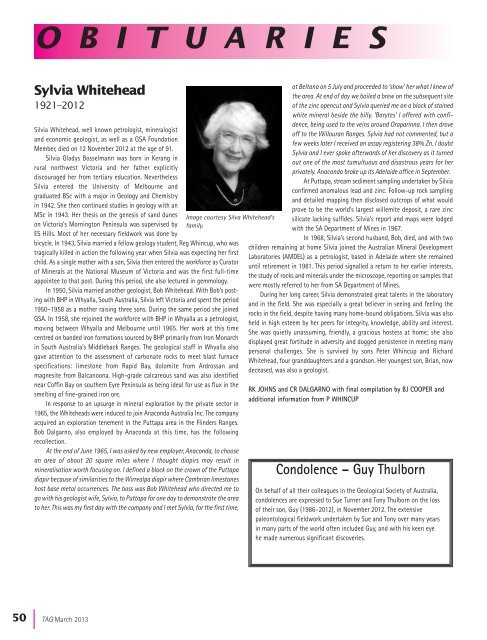TAG 166 - Geological Society of Australia
TAG 166 - Geological Society of Australia
TAG 166 - Geological Society of Australia
Create successful ePaper yourself
Turn your PDF publications into a flip-book with our unique Google optimized e-Paper software.
O B I T U A R I E SSylvia Whitehead1921–2012Silvia Whitehead, well known petrologist, mineralogistand economic geologist, as well as a GSA FoundationMember, died on 12 November 2012 at the age <strong>of</strong> 91.Silvia Gladys Bosselmann was born in Kerang inrural northwest Victoria and her father explicitlydiscouraged her from tertiary education. NeverthelessSilvia entered the University <strong>of</strong> Melbourne andgraduated BSc with a major in Geology and Chemistryin 1942. She then continued studies in geology with anMSc in 1943. Her thesis on the genesis <strong>of</strong> sand duneson Victoria’s Mornington Peninsula was supervised byES Hills. Most <strong>of</strong> her necessary fieldwork was done byImage courtesy Silva Whitehead’sfamily.bicycle. In 1943, Silvia married a fellow geology student, Reg Whincup, who wastragically killed in action the following year when Silvia was expecting her firstchild. As a single mother with a son, Silvia then entered the workforce as Curator<strong>of</strong> Minerals at the National Museum <strong>of</strong> Victoria and was the first full-timeappointee to that post. During this period, she also lectured in gemmology.In 1950, Silvia married another geologist, Bob Whitehead. With Bob’s postingwith BHP in Whyalla, South <strong>Australia</strong>, Silvia left Victoria and spent the period1950–1958 as a mother raising three sons. During the same period she joinedGSA. In 1958, she rejoined the workforce with BHP in Whyalla as a petrologist,moving between Whyalla and Melbourne until 1965. Her work at this timecentred on banded iron formations sourced by BHP primarily from Iron Monarchin South <strong>Australia</strong>’s Middleback Ranges. The geological staff in Whyalla alsogave attention to the assessment <strong>of</strong> carbonate rocks to meet blast furnacespecifications: limestone from Rapid Bay, dolomite from Ardrossan andmagnesite from Balcanoona. High-grade calcareous sand was also identifiednear C<strong>of</strong>fin Bay on southern Eyre Peninsula as being ideal for use as flux in thesmelting <strong>of</strong> fine-grained iron ore.In response to an upsurge in mineral exploration by the private sector in1965, the Whiteheads were induced to join Anaconda <strong>Australia</strong> Inc. The companyacquired an exploration tenement in the Puttapa area in the Flinders Ranges.Bob Dalgarno, also employed by Anaconda at this time, has the followingrecollection.At the end <strong>of</strong> June 1965, I was asked by new employer, Anaconda, to choosean area <strong>of</strong> about 20 square miles where I thought diapirs may result inmineralisation worth focusing on. I defined a block on the crown <strong>of</strong> the Puttapadiapir because <strong>of</strong> similarities to the Wirrealpa diapir where Cambrian limestoneshost base metal occurrences. The boss was Bob Whitehead who directed me togo with his geologist wife, Sylvia, to Puttapa for one day to demonstrate the areato her. This was my first day with the company and I met Sylvia, for the first time,at Beltana on 5 July and proceeded to ‘show’ her what I knew <strong>of</strong>the area. At end <strong>of</strong> day we boiled a brew on the subsequent site<strong>of</strong> the zinc opencut and Sylvia queried me on a block <strong>of</strong> stainedwhite mineral beside the billy. ‘Barytes’ I <strong>of</strong>fered with confidence,being used to the veins around Oraparinna. I then drove<strong>of</strong>f to the Willouran Ranges. Sylvia had not commented, but afew weeks later I received an assay registering 38% Zn. I doubtSylvia and I ever spoke afterwards <strong>of</strong> her discovery as it turnedout one <strong>of</strong> the most tumultuous and disastrous years for herprivately. Anaconda broke up its Adelaide <strong>of</strong>fice in September.At Puttapa, stream sediment sampling undertaken by Silviaconfirmed anomalous lead and zinc. Follow-up rock samplingand detailed mapping then disclosed outcrops <strong>of</strong> what wouldprove to be the world’s largest willemite deposit, a rare zincsilicate lacking sulfides. Silvia’s report and maps were lodgedwith the SA Department <strong>of</strong> Mines in 1967.In 1968, Silvia’s second husband, Bob, died, and with twochildren remaining at home Silvia joined the <strong>Australia</strong>n Mineral DevelopmentLaboratories (AMDEL) as a petrologist, based in Adelaide where she remaineduntil retirement in 1981. This period signalled a return to her earlier interests,the study <strong>of</strong> rocks and minerals under the microscope, reporting on samples thatwere mostly referred to her from SA Department <strong>of</strong> Mines.During her long career, Silvia demonstrated great talents in the laboratoryand in the field. She was especially a great believer in seeing and feeling therocks in the field, despite having many home-bound obligations. Silvia was alsoheld in high esteem by her peers for integrity, knowledge, ability and interest.She was quietly unassuming, friendly, a gracious hostess at home; she alsodisplayed great fortitude in adversity and dogged persistence in meeting manypersonal challenges. She is survived by sons Peter Whincup and RichardWhitehead, four granddaughters and a grandson. Her youngest son, Brian, nowdeceased, was also a geologist.RK JOHNS and CR DALGARNO with final compilation by BJ COOPER andadditional information from P WHINCUPCondolence – Guy ThulbornOn behalf <strong>of</strong> all their colleagues in the <strong>Geological</strong> <strong>Society</strong> <strong>of</strong> <strong>Australia</strong>,condolences are expressed to Sue Turner and Tony Thulborn on the loss<strong>of</strong> their son, Guy (1986–2012), in November 2012. The extensivepaleontological fieldwork undertaken by Sue and Tony over many yearsin many parts <strong>of</strong> the world <strong>of</strong>ten included Guy, and with his keen eyehe made numerous significant discoveries.50 |<strong>TAG</strong> March 2013
















